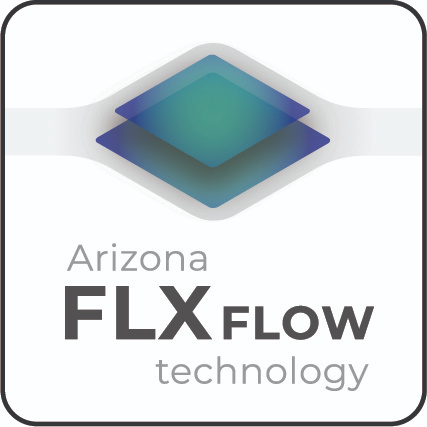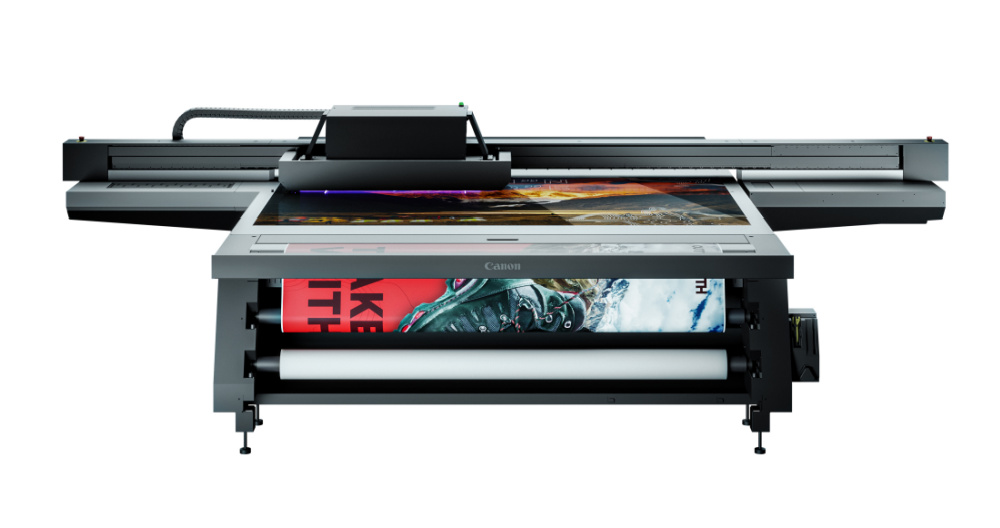Canon introduced the Arizona 2300 Series of UV-LED flatbed inkjet printers for mid- to high-volume of wide-format graphics in the fall of 2020. Earlier this year, they announced a innovative upgrade to its material handling capabilities.
Background
The Arizona 2300 printers are designed to help print-service providers speed up production, operate more efficiently, and fuel growth opportunities through new applications in the retail, interior decor, packaging, and industrial markets.
Like other models in the Arizona product line, the Arizona 2300 features a true stationary flatbed table structure. But what made the Arizona 2300 Printer Series different was its FLOW technology, a zone-free vacuum system.
The technology uses automatic measurement and adjustment of airflow levels to firmly and accurately hold various types of media in place. It enables operators to position the media on the flatbed with far less masking. The FLOW technology also made it faster to change from one type of material to another, and confidently print on odd-shaped, heavy, smooth, or pre-cut media without a jig.
FLOW technology facilitated printing on more challenging media such as wood, stretched canvas, and glass. It also made it easier to print unusual jobs such as print large images tiled across multiple large boards.

This year Canon rebranded its FLOW technology as FLXflow. It is now called FLXflow technology because it offers two modes: the traditional “hold” mode and a new “float” capability that pushes air upwards from the table to create a cushion.
This means heavy or challenging substrates can be easily positioned with minimal media damage or waste. The “floating without drifting” functionality enables several pieces of media to be precisely positioned at the same time. An Instant Switch option allows the operator to use a foot pedal to change from the “Hold” to “Float” function.
Six Models in the Series
The Canon Arizona 2300 series is available in two different bed sizes and with a choice of 4-channel, 6-channel, or 8-channel configurations for different combinations of inks and varnish. Printable materials can be up to 2 inches thick.
Max. Media Size: 49.2 x 98.4 in.
Arizona 2340 GTF: 4 channels (CMYK)
Arizona 2360 GTF: 6 channels (e.g, CMYK light cyan, light magenta or white + varnish)
Arizona 2380 GTF:8 channels (e.g. CMYK light cyan, light magenta, white, varnish
Max. Media Size: 121.3 x 98.4 in.
Arizona 2340 XTF: CMYK
Arizona 2360 XTF: CMYK plus two channels of white (or white + varnish)
Arizona 2380 XTF: CMYK light magenta, plus two channels of white and varnish
The 4-channel models can be upgraded to 6 channels.
The six-channel models can be upgraded to 8 channels.
Like other higher-end UV-LED flatbed printers, the 6-channel or 8-channel Canon Arizona 2300 printers can apply multiple layers of white ink and varnish to create tactile surfaces such as brushstrokes on an art canvas or lenticular images that give the illusion of motion.
Multi-layer printing enables print-service providers to explore higher-value applications such as textured permanent signage, product decoration, awards, decor, and embossed packaging.
To build textured or spot-varnish surfaces, designers or prepress personnal can use Canon’s PRISMAelevate XL software option to set up and soft-proof surfaces up to 4 mm high on the print. If errors are detected in a multi-layer print job on a costly print material,, the operator can make necessary adjustments before the job is printed.
PRISMAelevate XL v.21 also helps make prints durable without additional finishing steps, such as lamination, coating, or spray varnishing.
Prisma XL Suite of Software
Canon’s Prisma XL Suite is part of Canon’s PRISMA portfolio of workflow solutions for digital printers and presses. The Prisma XL Suite offers choices such as the easy-to-use PRISMA XLguide.
XLguide uses plug-ins to Adobe Photoshop and Illustrator software and pre-defined recipes help designers and prepress personnel build and preview print-ready files for specific types of jobs or Canon’s flatbed Arizona and roll-to-roll Colorado printers. The software can also save the steps from custom jobs into recipes that can re-used for repeat jobs.
The VariaDot Gen3 technology in Arizona 2300 flatbed printers offers new print modes that give operators the flexibility to achieve better quality at the same speed or maintain the same quality at higher speeds.
The software includes an optional interface that connects to third-party automation systems for continuous loading and unloading media.
Plus, production data from Arizona 2300 flatbed printers with FLXflow technology can be fed directly into the accounting systems used in the ONYX Hub or OneVision software. This gives users greater visibility over operations.
Productivity is further enhanced by the PRISMAservice option that maximizes uptime by providing predictive maintenance and authorized remote assistance by qualified service technicians.
For More Information
Current users of the Arizona 2300 with FLOW technology can upgrade their printer to the latest version with FLXflow functionalities, including the optional Float and Instant Switch features.
“At Canon we’re committed to advancing our flatbed technology, driven by our close collaboration with both the market and our valued stakeholders. From refining printer ranges to enhancing supporting software, we strive for continuous evolution,” said Shinichi “Sam” Yoshida, executive vice president and general manager, Canon U.S.A., Inc. “We eagerly anticipate the inventive applications our customers will unveil with these enhanced functionalities and options.”
For more information about Canon’s full line of Arizona flatbed printers, visit: https://csa.canon.com/internet/portal/us/csa/products/large-format/arizona-large-format-uv-flatbed-printers/
For more information on FLXflow, watch this short video:

